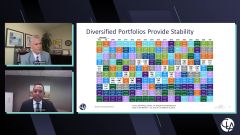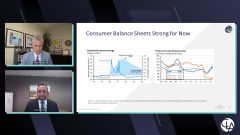Key insights
- Trends indicate a robust economy supported by strong consumer spending and transformative wealth transfers. CLA is predicting the rest of 2024 is characterized by a sense of resilience and optimism.
- Market sentiment is leaning toward a growth mindset, with the economy showing strength and businesses focusing on expanding and managing costs effectively.
- Within investing, a diversified portfolio is strategically designed to mitigate market volatility. It serves to both preserve and augment capital.
Curious about the many benefits of a diversified portfolio?
Despite historical challenges, current data indicates a robust economy supported by strong consumer spending The CLA Outlook for the rest of 2024 is characterized by a sense of resilience and optimism even as interest rates remain higher for longer.
Taking a diversified approach to investment — focusing on efficiency and real-time data — can help you navigate the evolving market landscape. Elevated interest rates bring businesses an opportunity to refine cost structures, and strategic planning is key.
The bond market — after experiencing a downturn — provides a cautionary tale of interest rate hike impacts. Equities, on the other hand, continue to show promise, especially when approached with valuation sensitivity.
A resilient forecast amid transformative trends
The CLA Outlook combines top-down economic data with market insights across various industries. For 2024, the outlook focus is on resilience and a back-to-basics strategy in market approaches, emphasizing the importance of strong profit margins while controlling costs.
Looking at the bigger picture shows that there are also megatrends at work including Industry 4.0, the workforce of the future, stewardship, and historic wealth transfer are shaping the economic landscape. Robust consumer spending is fueling economic resilience despite the backdrop of higher interest rates. The CLA Outlook also considers increased productivity gains through data analysis and real-time decision-making across all sectors.
Despite some challenges — including high interest rates and political uncertainties — the economy's underlying strength supports a constructive view into 2024 and 2025. Still, it’s prudent to safeguard business and personal finances through diversifying income streams and preparing for potential regulatory changes.
The theme for 2024 is not recession, it's resilience. There’s robust consumer spending. We're still seeing growth even despite the fact interest rates are at multi-decade highs.
Navigating market sentiment and investment opportunities
Market sentiment is leaning toward a growth mindset, with the economy showing strength and businesses focusing on expanding and managing costs effectively.
Continued robust consumer spending is supported by excess household savings, which have been influenced by government stimulus and significant intergenerational wealth transfers. Delinquency rates on various loans, while showing a mild uptick, remain within historical norms, suggesting the continued financial health of consumers.
Bonds and fixed income have traditionally been viewed as safer portfolio components. However, 2022 witnessed a significant downturn in fixed income returns, with a minus 13% return, largely due to interest rate hikes.
The 10-year U.S. Treasury yield spiked from 1% in January 2021 to 5% in October 2023, demonstrating remarkable movements in the bond market. These shifts impacted a range of fixed income instruments, from municipal to high-yield bonds and preferred securities. However, the current yield environment is now favorable for income portfolios and provide a cushion against equity market downswings.
Equities, on the other hand, have shown resilience with the S&P 500, reporting over 15% annualized returns over the past 15 years, outperforming international markets. This growth reflects positive market sentiment, as equities are forward-looking and consider present conditions.
The benefits of a diversified portfolio
Within investing, a diversified portfolio is strategically designed to mitigate market volatility. It serves to both preserve and augment capital. Historically, asset classes have demonstrated varying performance, underscoring the advantages inherent in a diversified investment approach.
For instance, fixed income assets — commonly perceived as the safer component of an investor's portfolio — experienced a significant downturn in 2022, with returns plunging to negative 13%. Conversely, the historical performance of the S&P 500 in the United States has been notably robust, with an annualized return exceeding 15% over a 15-year span.
A diversified portfolio consistently reduces the lowest returns and resists chasing the highest, thus maintaining a balance favoring steady growth and protecting investor capital.
0:46

Navigating economic stability in a post-pandemic market
With the shift from Covid-related economic challenges to a present growth mindset, the economy and markets have transitioned from volatility to stability. Businesses that focus on controlling costs and driving revenue are well-positioned for sustainable growth.
Within industries, manufacturing is still struggling with high inventory and labor costs, while the services sector is outperforming despite previous challenges.
Services’ resilience is evident through its ability to maintain revenue and fees without significant cost-cutting measures, indicating a strong demand for services throughout the pandemic and beyond.
In contrast, manufacturing is grappling with increased prices for materials such as corrugated boxing and elevated ocean freight costs, in addition to other factors contributing to financial strains. To help balance challenges, manufacturers are doubling down on using data to improve processes, from factory lines to distribution and inventory costs, showcasing an industry-wide commitment to efficiency and innovation.
The resilience of the U.S. economy — underpinned by strong consumer spending and innovative business strategies — presents a positive outlook for the year ahead.
How excess savings and wealth transfer are boosting consumer spending
Consumer spending resiliency is currently supported by excess savings and a significant wealth transfer.
Excess savings — bolstered by government stimulus during the COVID-19 pandemic — have provided a cushion for consumer spending. This financial buffer is evident in the continued robustness of consumer behavior, despite some upticks in loan delinquency rates, which are seen as a return to long-term norms rather than an immediate cause for concern.
An enormous amount of wealth is being passed down from older generations to younger ones, with estimates reaching into the trillions of dollars. This transfer has a profound impact on consumer spending patterns and overall economic vitality, as recipients of this wealth are likely to continue fueling consumption and investment activities.
It’s also leading to the creation of foundations and an increase in charitable giving, reflecting the diverse uses of transferred wealth. These dynamics underpin the strength of the consumer sector, which is a critical driver of the U.S. economy.
Dig deeper into the CLA Outlook
Looking for more insights into the economy, markets, and industries for the rest of 2024? Check out more highlights from our Q2 2024 CLA Outlook, as well as our full webinar.
How we can help
Despite a mostly bullish 2024 outlook, there are still headwinds to monitor, including continued high interest rates and the upcoming elections. And even in good times, portfolios benefit from strategic planning. CLA’s integrated private client services team approach delivers comprehensive wealth planning strategies to help you accomplish your specific financial, life, and legacy goals.
Contact us
Curious about the many benefits of a diversified portfolio? Complete the form below to connect with CLA.
If you are unable to see the form below, please complete your submission here.

